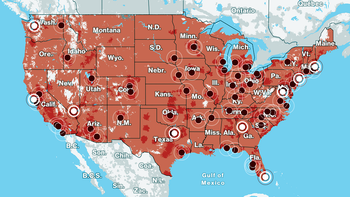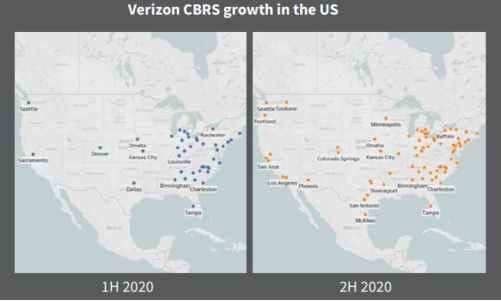How Verizon's 4G network turned out faster than the 5G ones

Not long ago, a Verizon network speed test returned blazing 3Gbps+ on its fast-but-limited mmWave coverage, but "only" 358Mbps on its newfangled "nationwide 5G" network. Adding insult to injury, the same PCMag test showed 600Mbps+ speeds on Big Red's 4G network. What's the point of owning a 5G phone again?
We kid, as there is more in play here than meets the eye. Granted, T-Mobile laid out its 5G network expansion plans recently, and they only promise 400Mbps average speeds by the end of 2023 which is seemingly slower than what Verizon can offer right now on its new 4G network bands. What gives? Here's the scoop.
Verizon 5G FOMO? Not really...
Last year, the FCC made 350 megahertz available for licensed commercial use within the shared Citizens Broadband Radio Service (CBRS) 3.5 GHz band, and the C-band spectrum at up to 4.2 GHz. Big Red scooped up quite a bit of those yet, interestingly, Verizon's CFO Matt Ellis went on record saying during an investor conference that they view the two spectrum bands from very different standpoints:
If you start with CBRS … it’s something that certainly we see as being complementary within our LTE network experience initially and then eventually it could be part of the 5G as well.
Recently, a RootMetrics report showed that Verizon’s usage of the CBRS spectrum has expanded by 70% across the US in the second half of 2020, from 41 to 70 markets in total.
In it, the field testing company takes Philadelphia as a case study and found that the carrier’s maximum download speed of 692.1 Mbps on CBRS was nearly 300 Mbps faster than its max speed of 404.9 Mbps without CBRS, and the median speed was double what its 4G LTE network achieved without the CBRS deployment.

Verizon's CBRS network expansion
What about 5G? It's complicated, as not that many phones support the needed n48 5G band just yet, certainly not the iPhone 12 family, so Verizon is currently increasing its "nationwide 5G" coverage by a technology called Dynamic Spectrum sharing (DSS). It basically lets it use 4G spectrum for 5G on the same equipment, and is a stopgap measure until the mid C-band and high mmWave bands are fully deployed this year and the next.
According to Mike Thelander, CEO of research firm SRG: "DSS is kind of that tool that allows them to make a migration from 4G to 5G data traffic, but definitely today, there’s a penalty to be paid. If you’re going to allocate spectrum or capacity between 4G and 5G, you want it to be as dynamic as the traffic in your network. That’s why the way Ericsson is doing it is what operators want. But it comes with this penalty, right now, due to interference."
DSS is something the iPhone 12 series supports in both of its flavors, so Verizon is using it to bring that coveted 5G icon on your phone's display in more and more places, the thing is that the majority of traffic then still goes through the 4G equipment, while the handoff is rather inefficient. That is why if there is CBRS 4G LTE connection in the same area, it is almost twice faster than the "nationwide 5G" offered for bragging rights, and yet offering a very stable connection:
CBRS provides excellent reliability: Not only did CBRS help Verizon deliver improved speeds, the carrier’s download reliability results on CBRS spectrum were outstanding. Verizon’s download reliability success rates on CBRS were nearly 100%, matching what RootMetrics recorded when not on CBRS in Philadelphia.
In short, while Verizon is still in its 5G strategy deployment infancy, it is simultaneously investing in a 4G network technology boost that won't make you miss 5G for a second in the foreseeable future, as it will offer average speeds not much different than what T-Mobile can get to with the mid-band 5G deployment it got from the merger with Sprint. This is especially true given that Verizon has the best network coverage outside of big city areas, and that's what matters more than pure network speeds, or whatever other goodies 5G is about to bring.













Things that are NOT allowed: